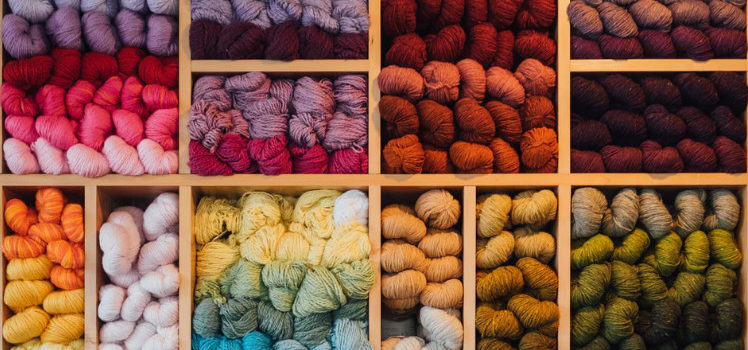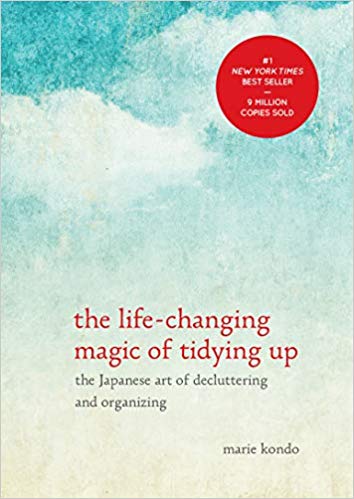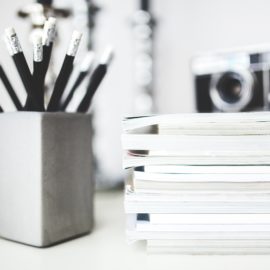

This article is an excerpt from the Shortform summary of "The Life-Changing Magic of Tidying Up" by Marie Kondo. Shortform has the world's best summaries of books you should be reading.
Like this article? Sign up for a free trial here .
The basic process of the Konmari method is to discard first, then organize what’s left.
Discarding requires you to ask whether an item sparks joy. If it does, keep it. If it doesn’t, thank it for everything it’s done for you. Then move it to the discard/donate pile.
After you’ve discarded items in a certain category, then you can move on to organizing what’s left in that category. When you organize, keep your storage as simple as possible: use what your home already has, as opposed to buying a lot of complicated storage solutions that ultimately end up cluttering your space more.
Ideally, you should be able to see everything you own at a glance and get whatever you need easily. Vertical storage is better than horizontal storage to accomplish this, like books upright on a bookshelf instead of stacked on top of each other–it’s much easier to see all your books and take a single book out when they’re organized vertically.
Chapter 4: Marie Kondo’s Organizing
For a given category in the Konmari process, you’ve made it through the discarding phase. Now your next task is to find a place for each remaining thing, and put each thing in its place.
It may seem like this will take a long time, but it won’t take as long as discarding. You’ve only got to find a spot for each item once. Items without designated spots are much more likely to end up all over the place, causing you to rebound back into clutter.
When you are deciding what to keep or discard, ask your heart. But when it comes time to decide where to put things, ask your house. Your home has enough space to contain the things you need–the trick is to learn how to store everything properly.
Common Mistakes in Organizing
Many people think they organize to “go with the flow of their house”–that the layout of their house determines what goes where. But if you look at their organization and the subsequent flow, it’s actually not determined by the house or anything other than where they’ve decided to store things.
Flow doesn’t determine where we store things. Instead,where we store things dictates the flow of our daily lives.
For example, a lot of people put a long, thin table near the front door as a place to put mail, keys, and anything they either need when they leave the house or want to put down immediately upon coming home. But then mail tends to pile up on this table, because it’s not actually an effective place to put mail that needs to be opened–it’s just the easiest place to drop it. The house didn’t force them to use the hallway as a space for mail–the storage method the homeowners chose determined where the mail ends up.
People often end up putting things in places where it’s easiest to access them fastest. This is a trap, and a surefire way to clutter your house up. When we keep things at arm’s length, that’s usually where they end up staying, and suddenly your house is covered in things always an arm’s length away.
- The average home isn’t large enough for it to be much of a hassle to organize things more simply. If it only takes you 10-20 seconds to walk from one end of your house to another, is that really too much time to walk somewhere to get something?
- Tidying is about putting things away, not taking things out. Storage should decrease the effort needed to put things away, not the effort needed to take them out.
How to Store Things
The more general you are in your sorting, the easier it will be to find what you need.
Since you’ve already discarded according to category, now all you have to do is store those things near each other. Don’t scatter storage throughout your house. Keeping categories together will be the simplest way of keeping track of what you have, accessing what you need where you need it, and not rebounding.
- For instance, many people keep their clothes in a bedroom closet, coats in a different closet, towels and sheets in a linen closet, kitchen towels under the sink–minor separate categories in different places. Then, they have to do mental work to remember where every one of those categories are. This is how we forget what we have–we spread it around our house.
- Instead, organize everything by general type: cloth-like things together, paper-like things together, electrical-like things together. This takes a lot of the stress and mental work out of organizing.
The best storage should let you see exactly what you have at a glance, without too much effort. To that end, vertical storage is better than horizontal storage.
- Piles can be endlessly added to–you can always stack more things on top of each other. Infinite storage is bad for organization, and great for clutter. Conversely, vertical storage runs out. You’ll know when you’ve accumulated too much stuff because you won’t have space for it.
- But piling things also puts a lot of strain on the things at the bottom, and will cause them to deteriorate faster. Also, when things end up on the bottom of piles, that’s usually when we stop using them, either because they’re harder to get to, or because they don’t spark joy and we use them less frequently, so they ended up there.
We’ll talk more about storage for each category later, but here’s what vertical storage looks like for clothes. When you pull out a drawer, items are shown vertically, so you can see all the items at once:

Avoid Alternative Storage
Don’t turn to alternative storage solutions–extra sets of drawers, tiered shelving units, containers that open up into many smaller drawers and containers. If you need additional storage options, you probably haven’t discarded successfully…
———End of Preview———

Like what you just read? Read the rest of the world's best summary of Marie Kondo's "The Life-Changing Magic of Tidying Up" at Shortform . Learn the book's critical concepts in 20 minutes or less .
Here's what you'll find in our full Marie Kondo summary :
- The psychological benefits of tidying
- How to Tidy the Konmari method
- How to deal with Clothing, Books, Papers, and Sentimental Items
- ...and much more






